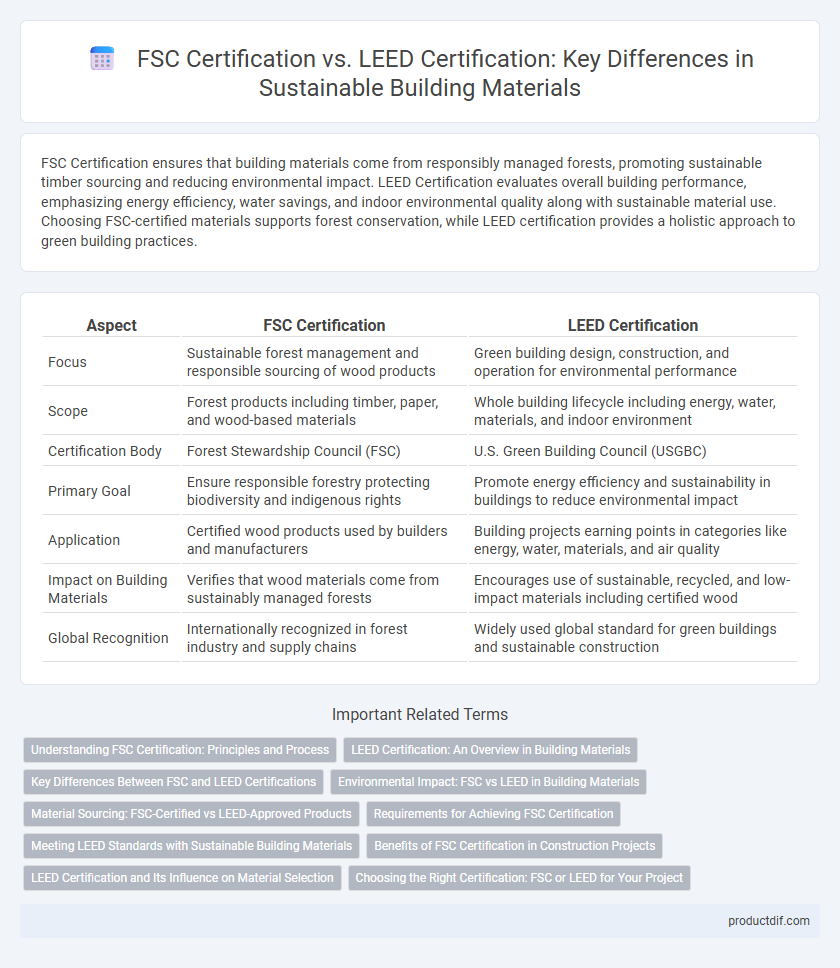FSC Certification ensures that building materials come from responsibly managed forests, promoting sustainable timber sourcing and reducing environmental impact. LEED Certification evaluates overall building performance, emphasizing energy efficiency, water savings, and indoor environmental quality along with sustainable material use. Choosing FSC-certified materials supports forest conservation, while LEED certification provides a holistic approach to green building practices.
Table of Comparison
| Aspect | FSC Certification | LEED Certification |
|---|---|---|
| Focus | Sustainable forest management and responsible sourcing of wood products | Green building design, construction, and operation for environmental performance |
| Scope | Forest products including timber, paper, and wood-based materials | Whole building lifecycle including energy, water, materials, and indoor environment |
| Certification Body | Forest Stewardship Council (FSC) | U.S. Green Building Council (USGBC) |
| Primary Goal | Ensure responsible forestry protecting biodiversity and indigenous rights | Promote energy efficiency and sustainability in buildings to reduce environmental impact |
| Application | Certified wood products used by builders and manufacturers | Building projects earning points in categories like energy, water, materials, and air quality |
| Impact on Building Materials | Verifies that wood materials come from sustainably managed forests | Encourages use of sustainable, recycled, and low-impact materials including certified wood |
| Global Recognition | Internationally recognized in forest industry and supply chains | Widely used global standard for green buildings and sustainable construction |
Understanding FSC Certification: Principles and Process
FSC Certification ensures responsible forest management by adhering to ten principles, including legal compliance, workers' rights, environmental impact, and community relations, verified through a rigorous third-party audit process. It emphasizes traceability of wood products from forest to final product, promoting sustainable sourcing and biodiversity conservation. Understanding these principles and the certification process helps builders and architects choose materials that align with environmental stewardship and responsible sourcing.
LEED Certification: An Overview in Building Materials
LEED Certification in building materials emphasizes sustainable sourcing, energy efficiency, and reduced environmental impact throughout the product lifecycle. It benchmarks materials based on criteria such as recycled content, low-emitting properties, and regional sourcing to support green building projects. LEED-certified materials contribute to achieving points in categories like Materials and Resources, enhancing overall building performance and sustainability ratings.
Key Differences Between FSC and LEED Certifications
FSC Certification primarily focuses on responsible forest management and sustainable sourcing of wood products, ensuring that materials originate from well-managed forests meeting strict environmental and social standards. LEED Certification assesses the overall environmental performance of buildings, including energy efficiency, water conservation, and sustainable materials use, encompassing a broader scope beyond just sourcing. While FSC targets the supply chain of timber, LEED evaluates the entire building's sustainability footprint, making both certifications complementary but distinct in the building materials industry.
Environmental Impact: FSC vs LEED in Building Materials
FSC Certification ensures building materials come from responsibly managed forests, promoting biodiversity and reducing deforestation. LEED Certification evaluates the overall environmental impact of building projects, including energy efficiency, water use, and material sustainability. FSC focuses specifically on forest stewardship, while LEED offers a broader assessment of environmental performance in construction.
Material Sourcing: FSC-Certified vs LEED-Approved Products
FSC certification ensures materials come from responsibly managed forests, guaranteeing transparency and sustainability in wood sourcing. LEED certification evaluates broader environmental performance, including energy efficiency, water use, and indoor environmental quality, while awarding credits for using certified sustainable materials like FSC wood. Choosing FSC-certified products supports responsible forest management, whereas LEED-approved products contribute to overall green building standards and environmental impact reduction.
Requirements for Achieving FSC Certification
FSC Certification requires strict adherence to sustainable forest management standards, ensuring timber is harvested in environmentally responsible, socially beneficial, and economically viable ways. The certification process involves rigorous chain-of-custody tracking, independent audits, and compliance with criteria such as preserving biodiversity, protecting water resources, and respecting indigenous rights. Achieving FSC Certification demonstrates commitment to transparency and sustainability in building materials sourcing, making it essential for eco-conscious construction projects.
Meeting LEED Standards with Sustainable Building Materials
Meeting LEED standards with sustainable building materials requires careful selection of products that contribute to energy efficiency, water conservation, and indoor environmental quality. FSC-certified wood ensures responsible forest management and renewable sourcing, aligning with LEED criteria for sustainable sourcing and materials transparency. Utilizing FSC-certified products can significantly contribute to LEED credits in Materials and Resources, promoting environmental stewardship throughout the building lifecycle.
Benefits of FSC Certification in Construction Projects
FSC Certification ensures sustainable sourcing of wood materials, promoting responsible forest management and reducing environmental impact in construction projects. This certification enhances supply chain transparency and supports biodiversity conservation, making it a preferred choice for eco-conscious builders. Compared to LEED, FSC focuses specifically on forest products, providing a clear guarantee of sustainability in timber and wood-based construction materials.
LEED Certification and Its Influence on Material Selection
LEED Certification prioritizes sustainable building practices by emphasizing energy efficiency, resource conservation, and reduced environmental impact through responsible material selection. This certification influences builders to choose materials with low embodied carbon, recycled content, and locally sourced components to achieve higher LEED points. Consequently, LEED drives innovation in eco-friendly building materials, steering industry trends toward greener construction.
Choosing the Right Certification: FSC or LEED for Your Project
FSC certification ensures responsible sourcing of wood and forest products by verifying sustainable forestry practices, making it ideal for projects prioritizing raw material traceability and biodiversity conservation. LEED certification evaluates overall building performance with criteria including energy efficiency, water use, and indoor environmental quality, suitable for projects aiming to achieve comprehensive green building standards. Selecting between FSC and LEED depends on whether the project emphasizes sustainable material procurement or holistic environmental impact across the entire building lifecycle.
FSC Certification vs LEED Certification Infographic

 productdif.com
productdif.com